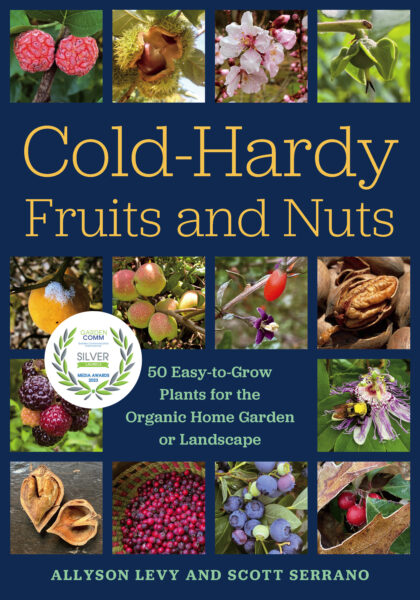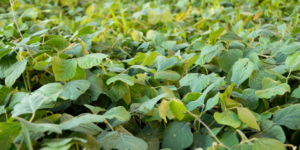Planting, Transplanting, and Pruning Trees
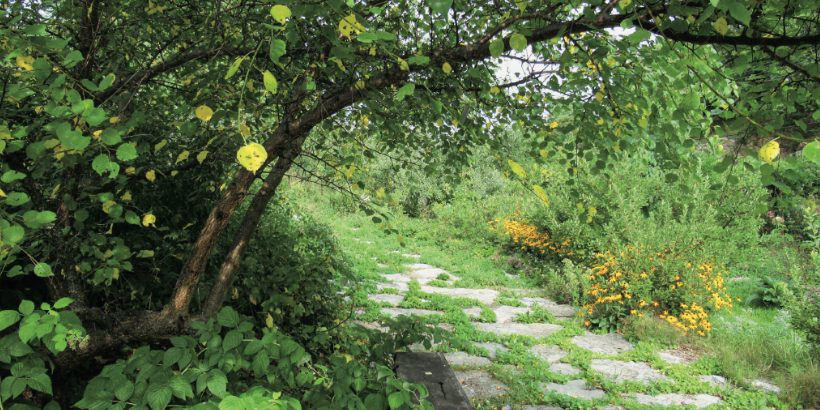
Interested in growing trees? Here are some tips on successfully planting, transplanting, and pruning trees to create a flourishing forest garden!
The following is an excerpt from The Home-Scale Forest Garden by Dani Baker. It has been adapted for the web.
Planting Potted Trees and Shrubs
If you order potted trees, check with your supplier to find out where the plants were stored before being shipped.
If they were kept in a heated greenhouse or another location with ambient temperatures significantly warmer than your outdoor conditions, you probably need to harden off the plants.
Hardening off involves gradually exposing plants to the outdoors by putting them outside for a short time the first day and gradually increasing exposure time over the next few days until the plants are left outdoors for a full 24 hours.
Getting Started
When a potted tree is adequately hardened off and you are ready to plant, water the root ball thoroughly. The best way to do this is to submerge the potted plant in a bucket of water in an upright position until air bubbles cease to rise to the surface. Then remove it from the pot and inspect the roots.
If the roots are root-bound—encircling the outer surface of the root ball—trim them with a scissor or clippers until you can spread out the still-attached roots to examine their expanse.
If you plant trees or shrubs in the root-bound state, the roots will likely continue to grow in this manner, circling round and round within the planting hole, and your plant will struggle to survive.
Once you’ve trimmed the roots as needed, place the root ball back in the pot or otherwise protect the root ball from the air and sun while you are digging a planting hole to size.
Place the root ball in the hole to make sure the depth and width of the hole are adequate. Then plant as described previously, spreading out any loose roots to encourage their outward growth.
If the root ball is a solid mass of fine roots, you needn’t build the mound of topsoil to spread the roots around. Just place the bottom of the root mass on the bottom of the hole and fill in around it. Water it well, then apply a trunk guard and mulch.
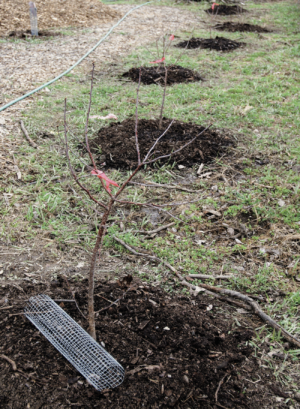
This row of newly planted cherry trees is ready to have trunk guards installed to protect them from bark-chewing rodents. Then more mulch will be added to retain moisture and keep weeds away.
Transplanting Trees and Shrubs
As your garden develops, there will be occasions when you need or wish to move an established plant. You may decide that a tree would do better in a new habitat that you think will be more conducive to its growth.
Or you may want to relocate a shrub that is becoming too crowded or shaded by neighboring plants.
When transplanting, the goal is to capture as much of a plant’s root structure as you can, retaining as much of the soil surrounding the roots as possible.
This will give the plant the best chance of establishing itself successfully in its new location. Here’s the technique:
A Technique for Transplanting
- Make vertical cuts with a shovel in the soil around the plant at a distance about half the height of the bush or tree. These cuts should overlap so you create a continuous vertical slice encircling the roots. If the plant is 1 foot (30 cm) tall, a circle with a 6-inch (15 cm) radius is probably sufficient. The depth of the cuts also depends on the size and root structure of the plant. For shallow roots, cuts 6 inches deep may capture most of the roots. If the plant has deeper roots or a taproot, dig deeper to capture as much of the root mass as possible.
- Begin digging down deeper and toward the tree. Your goal is to extricate the roots in a bowl-shaped mass with the soil intact. You may encounter roots that you need to cut through using the point of the shovel or a pruning implement.
- Once you have cut through all the roots you encounter, spread a damp cloth on the ground nearby.
- Extricate the root ball from the hole, wrap it in the damp cloth to shield the exposed roots from the air, and transport it to the new location. Depending on the size of the tree, a root ball can be quite heavy; you may need help to move it.
- At the new site, dig a hole to match the size and shape of the root ball you have extricated.
- Remove the cloth and lower the root ball into the hole. The surface of the root ball should be level with the soil surface surrounding the hole.
- Use the excavated soil to fill in any gaps between the root ball and the sides of the hole.
- Apply some water to settle this soil, and add more soil again until it is level with the surrounding surface.
- Use more of the removed soil to build a raised circle around the tree to form a saucer to hold water.
- Water the tree just until the water begins to pool.
Finish by applying a trunk guard and mulch as described previously in the instructions for planting a bare-root tree. Sometimes soil does not adhere well to the roots, but instead falls away, leaving the roots bare. In this case wrap the roots in a wet cloth and follow the instructions for planting a bare-root tree.
Pruning
Pruning is the practice of selectively removing branches from a tree or bush. In nature, “pruning” occurs randomly when branches are broken or damaged by a windstorm, a fire, or the nibbling of wild ruminants.
In a garden or farm setting, though, productivity and health of plants improves when limbs are systematically clipped.
Thinning branches improves air circulation to ward off disease, lets in light to hasten ripening, encourages blossoms and can result in fewer but larger fruits. Removing dead, damaged or diseased limbs helps prevent infestations from spreading to healthy growth.
Pruning also renews a tree or bush by encouraging growth of new branches that fruit more reliably than older ones.
If your space is limited or you prefer not to climb high to harvest fruit, you can prune to manage the size of your trees and shrubs.
Pruning can also result in plant forms that are more resilient and aesthetically pleasing or in dense growth of a hedge. Removing lower limbs of a tree can allow more light to bathe plants below.
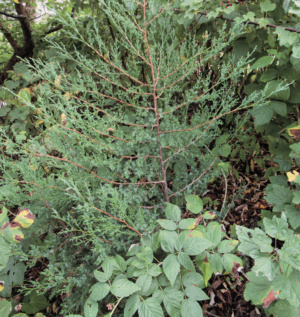
This volunteer cedar tree chose to grow nestled between red currants and raspberries in the shade of an apricot tree.
Learning to Prune
Each type of tree or shrub you plant may require slightly different pruning techniques.
Permaculturist Sepp Holzer does not prune any of the plants on his extensive permaculture farm in Austria. That is an option for you as well, especially if you have a good deal of acreage and prefer to let your forest garden remain more natural.
But if you would like to actively enhance the health and productivity of your plants, it is wise to apprise yourself of pruning basics.
Most domesticated fruit trees benefit from pruning to enhance the quality of their fruit.
I am admittedly a novice in this endeavor, though I tried my hand at pruning a few apple and peach trees the last few seasons.
I learned that this enterprise is as much an art as a science, and takes much practice to master.
I also observed that trees are resilient and will in most cases survive even the most egregious mistakes of the beginner.
How to Shape & Maintain
Shaping and maintaining trees and bushes when they are young promote the best form and growth from the get-go. In addition, pruning cuts heal more quickly when only young, thin branches are removed.
I recommend you seek expert advice to learn how best to maintain the plants you choose, and do so early on. Excellent references for pruning techniques can be found in the resource sections of some nursery websites and on YouTube. Your local cooperative extension office can also be a resource.
I recommend that you familiarize yourself with basic pruning principles and, if possible, apprentice yourself to a more experienced friend or neighbor to learn specific techniques.
Thinning Fruit
In addition to pruning, many fruit trees benefit from annual thinning of immature fruit. Thinning can remove diseased and distorted fruits while enhancing the size and quality of those remaining.
It is also a way of helping a young tree by allowing it to direct most of its energy into expanded growth rather than fruit production.
Each type of fruit tree will benefit from a slightly different thinning practice; consult your nursery or another source to determine the timing and technique best suited to your chosen trees.
Recommended Reads
Recent Articles
Everyone loves a refreshing, fermented, nutritious drink…even your garden! Take your fermentation skills out of the kitchen and into the garden by brewing fermented plant juice. The following is an excerpt from The Regenerative Grower’s Guide to Garden Amendments by Nigel Palmer. It has been adapted for the web. How to Make Fermented Plant Juice Fermented…
Read MoreWant to see your crops thrive this upcoming growing season? The key is in soil fertility and health. Spend time maintaining your soil’s health to guarantee bigger and better crops come harvest time! The following is an excerpt from No-Till Intensive Vegetable Culture by Bryan O’Hara. It has been adapted for the web. What Is Soil Fertility?…
Read MoreMany know the effects of catnip on our feline friends, but few realize that catnip has medicinal effects for humans. From stomach aches to reducing fevers, catnip is a versatile herb with many benefits. The next time you grow this plant for your cat you may end up taking a few cuttings for yourself! The…
Read MoreIt’s time to take control of your seeds and become a plant breeder! Saving your seed allows you to grow and best traditional & regional varieties, and develop more of your own. The following excerpt is from Breed Your Own Vegetable Varieties by Carol Deppe. It has been adapted for the web. Becoming A Plant…
Read MoreTrying to figure out how to manage weeds in your garden beds? Use cover crops and living mulches for weed suppression while your garden flourishes! The following is an excerpt from The Ecological Farm by Helen Atthowe. It has been adapted for the web. Suppressing Weeds With Cover Crops: Getting Started Cover crops suppress weeds…
Read More


